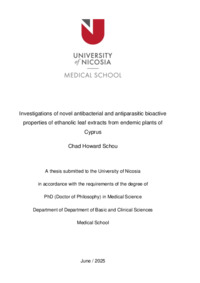- Schou, Chad
- Medical School
- Basic and Clinical Sciences
- 20 June 2025
- English
- 362
- Jovanovic, Aleksandar | Sarigiannis, Ioannis | Karanis, Panagiotis
- Anti-Acanthamoeba | Anti-Blastocystis | Antibacterial | Antibiofilm | Cyprus | Anti-Leishmania | Endemic plants
- Anti-Blastocystis -- Endemic plants
-
-
This study investigated the antibacterial, antioxidant, antiparasitic, and cytotoxic properties of ethanolic leaf extracts from endemic and indigenous Cypriot plants.
Antibacterial activity was assessed against six reference bacterial strains (four Gram-positive, two Gram-negative, American Type Culture Collection (ATCC): 6633, 29212, 6538, 12228, 25922, 27853), common human and animal pathogens, using a serial microdilution technique. Antioxidant properties were determined by measuring radical scavenging capacity, total phenolic content, and total flavonoid content. Antiparasitic effects were evaluated against Acanthamoeba castellanii (ATCC 30010), clinical isolates of Blastocystis hominis (subtypes 1 and 3) and clinical strain of Leishmania infantum (MCAN/CY/2005/CD57) using a trypan blue cell viability assay. Cytotoxicity was assessed in a mouse macrophage model via the Alamar Blue (resazurin) assay. An in vivo brine shrimp lethality assay revealed no general toxicity up to 1.25 mg/mL after 24 hours.
Among nine crude ethanolic leaf extracts, eight demonstrated significant in vitro antibacterial activity (MIC ≥ 0.3125 mg/mL) against at least one bacterial strain. Quercus alnifolia, Quercus × campitica (a hybrid of Q. alnifolia and Q. coccifera subsp. calliprinos), and Acer obtusifolium exhibited the highest activity against Staphylococcus aureus (ATCC 6538). Juniperus oxycedrus also showed strong activity with MICs of 0.3125 mg/mL and 0.625 mg/mL, respectively. Q. alnifolia and Q. × campitica extracts displayed potent radical scavenging capabilities, strongly correlating with their phenolic and flavonoid contents (R² > 0.99), and demonstrated significant in vitro antibiofilm activity against S. aureus (ATCC 6538).
Odontites linkii subsp. cyprius and Ptilostemon chamaepeuce subsp. cyprius ethanolic leaf extracts showed anti-Acanthamoeba activity at 12.5 mg/mL (26% and 65% cell viability, respectively) after 72 hours. Furthermore, O. linkii subsp. cyprius, P. cham. subsp. cyprius, and Q. alnifolia extracts exhibited strong anti-Blastocystis properties, achieving complete eradication of clinical isolates at 1 mg/mL within 48 hours. P. cham. subsp. cyprius was uniquely active against both promastigote and amastigote stages of a Leishmania infantum clinical strain in a mouse macrophage model, showing comparable effects to miltefosine.
High-resolution Liquid Chromatography-Mass Spectrometry (LC-MS) identified bioactive iridoids in O. linkii subsp. cyprius, quercetin derivatives in Q. alnifolia, and sesquiterpene lactones in P. cham. subsp. cyprius. This research provides the first evidence of antibacterial, anti-Acanthamoeba, anti-Blastocystis, and anti-Leishmania activities for these Cypriot endemic plant extracts, highlighting their significant potential as leads for novel drug development against bacterial and parasitic infections.
-


